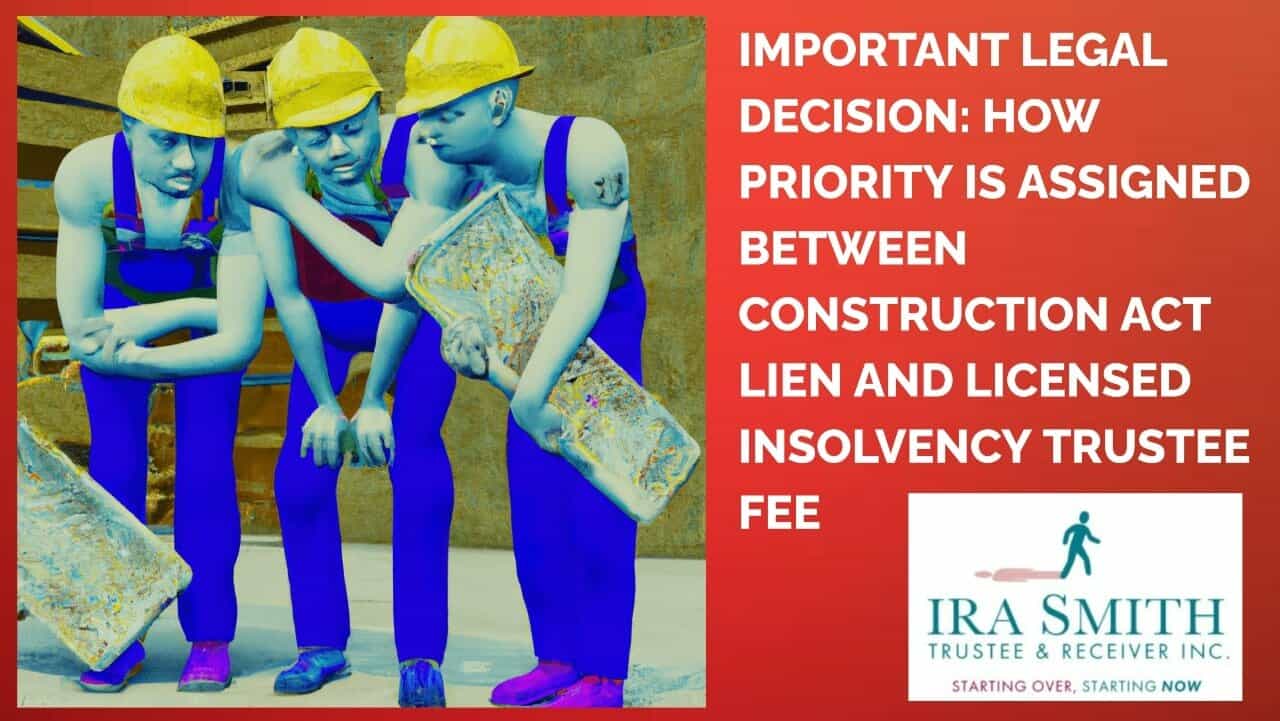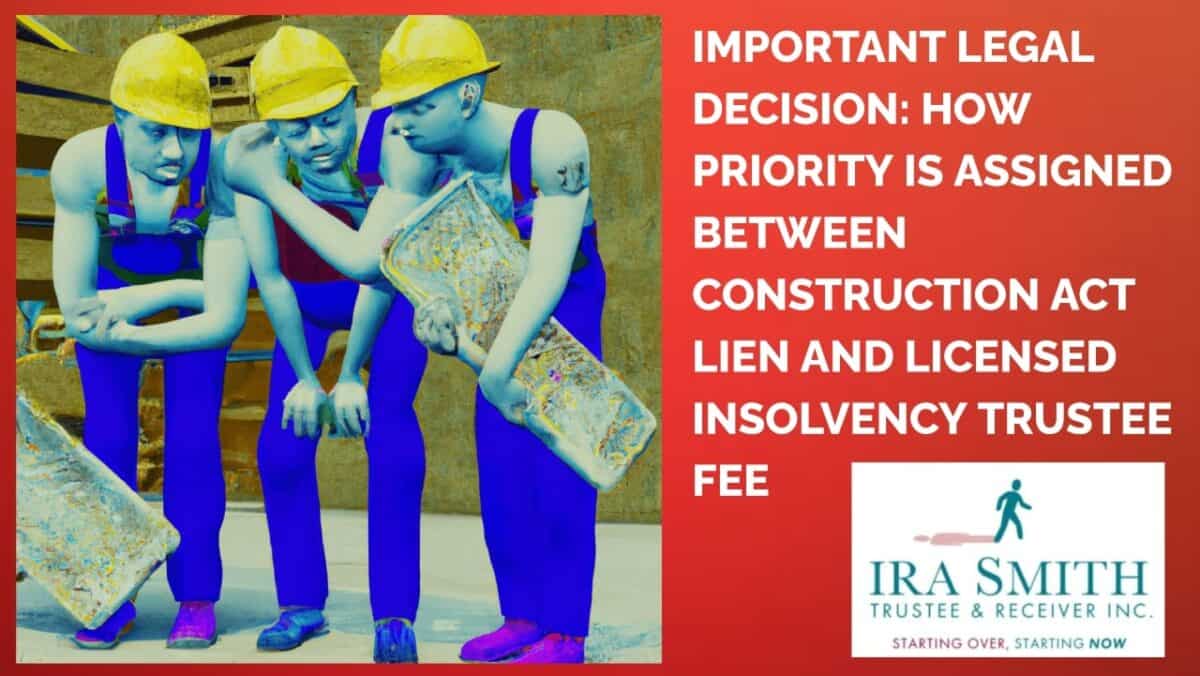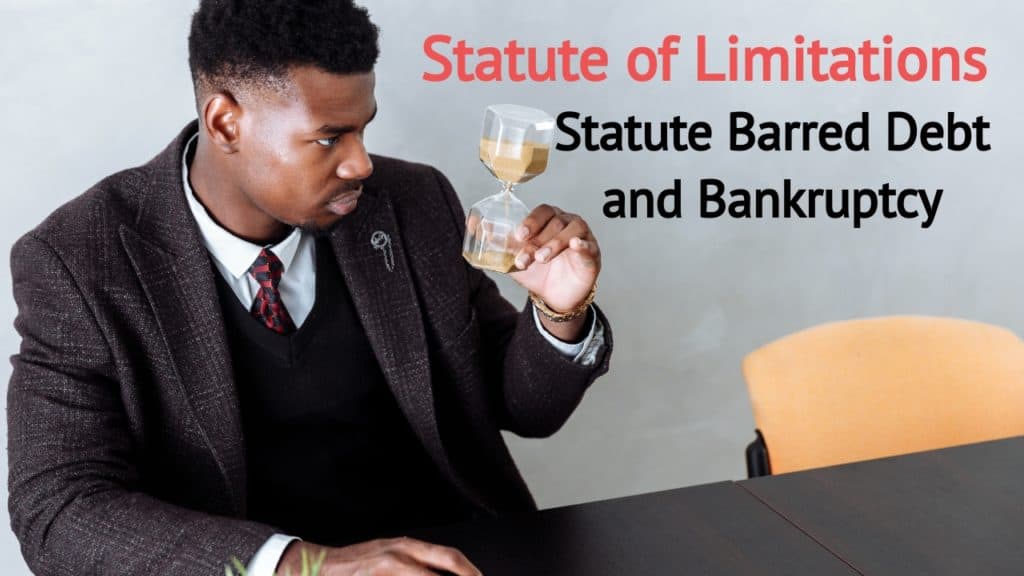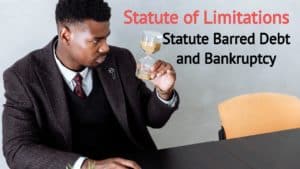Construction Act, R.S.O. 1990, c. C.30: Introduction
In May 2020, I wrote Brandon’s Blog CONSTRUCTION LIEN ACT: CAN YOU TRUST AN INSOLVENCY PROCEEDING?
In October 2021, I wrote CONSTRUCTION LIEN ACT OF ONTARIO: THE GRIPPING FIGHT BETWEEN LIEN FILING, A PRIOR MORTGAGE & RECEIVER FEES. In that blog, I wrote about what a construction lien is and a decision of the Court of Appeal for Ontario in a receivership context.
Now there is a decision released by the Alberta Court of King’s Bench of Alberta on February 15, 2023, regarding Golfside Ventures Ltd (Re), 2023 ABKB 86 (CanLII). This decision relies on the Court’s inherent jurisdiction rather than following a specific rule set out in the Bankruptcy and Insolvency Act (Canada) (BIA). Based on the specific facts of this case, this decision sets the priority between a construction lien and the fee and disbursements of a licensed insolvency trustee (formerly called a bankruptcy trustee).
I have compiled a comprehensive guide to help you understand the case’s implications. Our guide provides information on the Ontario Construction Act, R.S.O. 1990, c. C.30 (Construction Act) the background of the case, the decision, and what it means for stakeholders in the construction industry if this decision is not overturned on appeal (should an appeal be launched) and if this line of thinking was adopted in Ontario.
Our understanding hopefully provides clarity for contractors, builders, lawyers, lenders and other construction industry players. Following the Alberta Court’s decision, it is necessary to understand how a Construction Act lien will rank against other claims and especially the licensed insolvency trustee fees. Our guide will help readers learn:
- the importance of a construction lien
- the background of the case;
- what the Court’s decision was;
- the implications of the case; and
- how to protect their interests under similar circumstances.
We caution that we are not lawyers and especially not construction lawyers. Anyone involved in the construction industry needs to seek the advice of their legal counsel.
Our specialty is that of a licensed insolvency trustee. We will be jumping between the requirements of the Construction Act in Ontario and the Alberta Court decision. Since bankruptcy matters are federal law, while the Construction Act is provincial law, I feel that the comparison is apt.
What is the Ontario Construction Act?
The Construction Act is a piece of legislation in the province of Ontario. The act regulates the construction industry in Ontario and outlines the rules and requirements for construction contracts, requests for payment, the prompt payment regime and payment dispute resolution.
The Construction Act is divided into various parts, each dealing with different aspects of construction. Part II outlines the trust provisions and the interim dispute resolution provisions. Part III deals with the construction lien, which allows contractors and subcontractors to secure payment for work they have done. Part IV outlines the holdback provisions Part V of the act deals with the expiry, preservation and perfection of construction liens.
The current Construction Act came into being in September 2021. Before then Ontario had the Construction Lien Act. Overall, the Construction Act is an important piece of legislation for the construction industry in Ontario, providing a framework for fair and equitable treatment of all construction contracts, payment, and dispute resolution. As a business owner or contractor in the construction industry, it is essential to understand your rights and obligations under the Construction Act.
One very complicated area of this provincial law is the ranking of a Construction Act Lien against licensed insolvency trustee fees in the event of a company’s insolvency and bankruptcy. The recent decision from the Alberta Court sheds light on this topic and provides valuable insights for contractors, business owners and insolvency professionals.
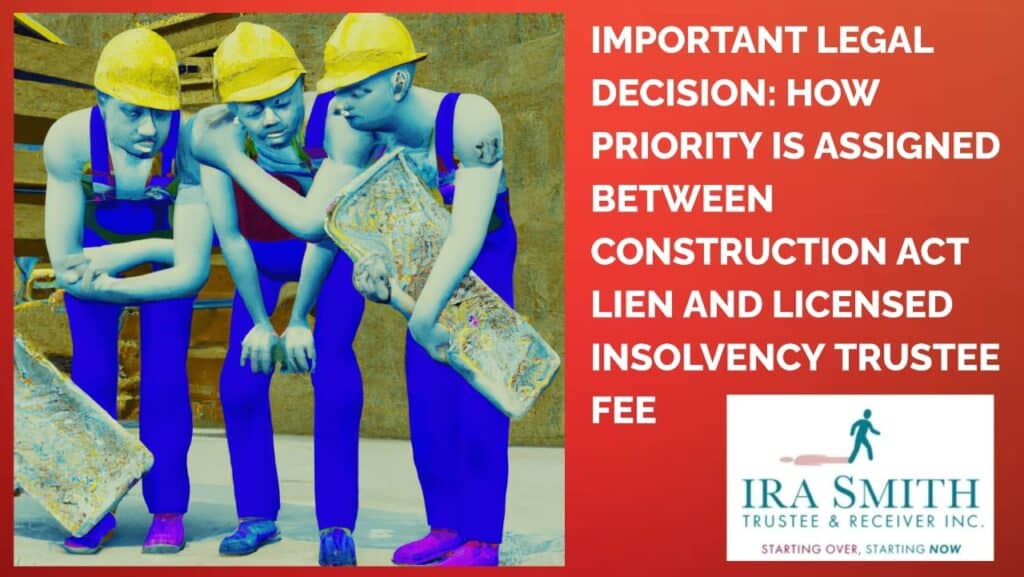
What is a construction lien under the Construction Act?
A construction lien is a legal claim against a property that is created by a contractor, subcontractor, or supplier who has provided labour or materials for the improvement of that property. The purpose of a construction lien is to secure payment for the work or materials provided by the claimant.
In Ontario, construction liens are governed by the Construction Act, which outlines the process for creating, perfecting, and enforcing liens. A construction lien arises when a contractor, subcontractor, or supplier provides work or materials to improve a property but is not paid for that work or materials. The lien gives the claimant the right to take legal action to enforce the claim for payment.
Please note: While I cannot claim expertise in this particular field, I have served as a Court-appointed receiver for incomplete construction projects as a licensed insolvency trustee. As such, I have gained valuable experience dealing with a variety of construction lien issues within the context of receiverships.
Improvements to the Construction Lien Act of Ontario in making the Construction Act has focused primarily on implementing prompt payment provisions and establishing mechanisms for resolving disputes, such as the adjudication regime. Under provincial construction law, the prompt payment rules refer to the timely payment of an invoice following the issuance of a “proper invoice.”
Specifically, contractors must receive payment for their work within 28 days of their invoice being received by the owner. The owner has 14 days to object to the amount, quality, or invoice of the work outlined in the invoice. Additionally, the time limit for filing/preserving liens has been extended from 45 days to 60 days.
The primary objective of this revised policy is to enhance cash flow management within the construction hierarchy by expediting conflict resolution and avoiding either late payment or non-payment. The newly implemented adjudication provisions are designed to resolve construction disputes proficiently with qualified adjudicators and a code of conduct for their ethical conduct.
In the event of a failure to extend the timeline, the adjudication regime mandates that the decision must be rendered within 46 days of initiation. If a party fails to comply with the adjudicator’s decision, the aggrieved party is entitled to halt or terminate work under the contract.
Under industry standards, holdbacks necessitate that the landowner, the contractor, or the subcontractor withhold a sum of 10% from the overall expense of materials or services rendered. It is permissible to furnish a bond or security deposit in place of the holdback contingent upon the provisions outlined in the contractual agreement.
To perfect a construction lien under the Construction Act, the claimant must follow a specific process. First, the claimant must provide written notice of their intention to lien to the owner of the property, the general contractor, and any other parties with an interest in the property.
After providing notice, the claimant must register the lien with the Ontario Land Registry Office after the last day the claimant provided work or materials. The registration of the lien must include specific information, such as the amount claimed, a description of the property, and the names of the parties involved.
Once the lien is registered, the claimant must take legal action to enforce the lien within a specific timeframe, or the lien will expire. This legal action results in the filing of a lawsuit to enforce the lien or participating in mediation or arbitration to resolve the dispute. There are specific time frames to all these steps under the Construction Act which must be followed.
Overall, construction liens provide important protections for contractors, subcontractors, and suppliers by allowing them to secure payment for their work or materials. However, the process of creating and enforcing a lien is complex. It is important to seek legal advice to ensure that the lien is properly perfected and enforced.
Definition and criteria for awarding licensed insolency trustee fees in a Canadian bankruptcy
In accordance with the BIA, a licensed insolvency trustee (LIT) in Canada is authorized by the federal government to oversee bankruptcies and proposals. It is mandatory for individuals or companies that file for bankruptcy to designate a LIT to manage the process.
The fees of a LIT in small consumer personal bankruptcy files are determined by a tariff established by the Office of the Superintendent of Bankruptcy. This tariff is meant to fairly compensate LITs in these small files.
In all corporate bankruptcy and larger personal bankruptcy administrations, the LIT’s fee depends on the complexity of the case, as well as the value of assets and liabilities involved. The LIT must have its fee and disbursements approved by the Court in these larger files.
It is imperative to acknowledge that a particular hierarchy is established in the BIA that determines the order of priority in which a LIT’s fees are paid from the assets of the bankrupt estate. Prior to any ordinary unsecured creditors, LITs are compensated after trust claimants, secured creditors, and preferred unsecured creditors. Consequently, any remaining funds earmarked for LITs’ remuneration will curtail the amount accessible to cover the claims of ordinary unsecured creditors.
This is where the issues in the Alberta case arise. Before agreeing to accept an insolvency assignment, the LIT needs to understand how they are going to get paid. In a bankruptcy where there are secured creditors, those creditors may suffer a shortfall and therefore there will be no money available for the LIT fees and disbursements, even if they are fully approved.
In such cases, the LIT must first get a sizable cash retainer or the indemnity of a third party who can afford to pay the fees and costs upfront. This must be done by the LIT BEFORE accepting the file. It is most important for the LIT to pay attention to how it is going to get paid for administering bankruptcy. There are certain red flags that must be identified when assessing a potential bankruptcy administration, especially for an unfinished construction project.

Different types of licensed insolvency trustee fees in a Canadian bankruptcy
LIT fees pertain to the charges levied by a Trustee for the range of services provided in the administration of a bankruptcy estate. These fees are extracted from the estate’s assets and are contingent on the intricacy of the case, the amount of time and effort invested by the Trustee, and the overall value of the assets in question.
According to the BIA, LIT fees are determined based on specific criteria that govern the administration of bankruptcy proceedings. Both the fees and expenses incurred by the Trustee and their legal representative must be approved by the Court. As a result, the LIT must acquire the Court’s authorization for their expenses and charges.
The Court holds the power to decide the amount and fairness of the Trustee’s fees. The Court considers several factors such as the complexity of the case, the amount of time invested by the Trustee, the value of the assets involved, and the quality and level of services rendered by the Trustee. The Court also takes into account the evidence of any party opposing the approval of the LIT’s fees as submitted for approval.
The services rendered by a LIT are subject to regulatory oversight under the BIA, which has established a framework for fees that can be charged by LITs. These fees are bifurcated into two categories:
- Administrative Fees: These fees are levied by LITs for the administrative work they perform during the bankruptcy process. They encompass a range of activities such as document preparation and filing, communication with creditors, and asset collection, realization and distribution.
- Disbursement Fees: LITs charge disbursement fees for expenses incurred while managing the bankruptcy. These expenses can range from fees for appraisers, Court filing fees, and legal fees, and are typically reimbursed from the debtor’s estate.
Importance of paying attention to bankruptcy trustee fees
Bankruptcy cases entail a diverse range of fees that creditors and relevant parties must meticulously monitor. Trustee fees are a significant aspect of these fees, as they could significantly impact the funds available for creditor payments. Thus, understanding the mechanics of these fees and their implications on your bankruptcy interests is crucial.
This is especially pertinent for those affiliated with the construction industry or those who supply products and services to construction projects. In recent years, there has been some confusion and uncertainty surrounding how Construction Act liens rank against Trustee fees in bankruptcy cases.
Regrettably, in my view, the recent judgment from the Alberta Court of the Golfside Ventures Ltd (Re), 2023 ABKB 86 (CanLII) decision has only served to exacerbate this ambiguity, rendering the matter even more perplexing.
The following is my take on the Golfside Ventures Ltd (Re), 2023 ABKB 86 (CanLII) decision.

Golfside Ventures Ltd (Re), 2023 ABKB 86 (CanLII): Recent legal decision How priority was assigned between Construction Act lien and Bankruptcy Trustee Fees
Background of the case
In February 2019, Golfside Ventures Ltd. and Hustle Holdings Ltd. joined forces through a Joint Venture Agreement to develop forty-four parcels of barren land in Redwater, Alberta, commonly known as the Lands. However, shortly after the agreement was made, Golfside was declared bankrupt, with the Lands remaining as its sole asset.
Prior to the bankruptcy, the Trustee conducted due diligence and determined, notwithstanding the registrations against the title, that there was sufficient equity in Golfside’s assets to cover the associated fees and expenses. The Trustee also obtained an agreement with a third-party company to postpone and subordinate any of its claims against Golfside.
Despite these measures, one of the mortgagees filed a Builders’ Lien against the Lands after the bankruptcy commenced, claiming approximately $5,500,000 in relation to the joint venture. The Trustee disallowed the lien claim, prompting the creditor to appeal.
The Trustee, in seeking guidance and direction from the Court, filed a motion for the granting of an Order creating a first charge on the assets of Golfside in favour of the Trustee’s fee and disbursements, including legal fees. This request was made to ensure that the Trustee’s reasonable professional fees and disbursements are secured in their payment. The Trustee is relying on the principles of fairness and the inherent jurisdiction of the Court in making this request.
The Respondents asserted that the Trustee should have been aware of the existence of a lien prior to their appointment. They argue that the rights of secured creditors, as outlined in the BIA, should govern this situation, with secured lien claims taking priority over the payment of fees and disbursements to a bankruptcy trustee.
So the issue before the Court was can, and if so, should, the Court exercise its inherent jurisdiction to grant a charge in favour of the Trustee against the Lands and the proceeds from the sale of the Lands to secure the Trustee’s costs?
Court’s ruling and reasoning
Section 39 of the BIA sets out Trustee remuneration. Secured claims rank in priority over a trustee’s fees and expenses. A trustee should arrange to protect itself before incurring fees, expenses, and legal costs to administer the estate.
The lien claimant as a secured creditor would have priority over the Trustee‘s fees and expenses in the case of bankruptcy. The BIA provides the priority scheme for distributing proceeds of a bankrupt’s estate. It is not clear if the Court’s inherent jurisdiction can be applied in this situation. If so, the claim for lien would have precedence over the Trustee’s fees and expenses.
The Trustee would be entitled to a portion of the amount remaining out of the realization of the property of the debtor after the claims of the secured creditors have been paid or satisfied (s 39(2) in this case). The claim for lien would have priority over the Trustees’ fees and expenses.
The Trustee submitted that the Court may exercise its inherent jurisdiction to grant the requested charge. The Respondents take the position that the BIA is very clear and that the Trustee who incurred fees and expenses did so at its own peril. The Trustee’s responsibility is to ensure that only valid claims to the assets under administration are recognized. Determining the validity and priority of claims has a real cost.
In a prior decision, the Court ultimately granted a Trustee a charge over funds in its possession to the extent necessary to permit recovery of 50% of its reasonable fees and disbursements.
The Trustee in this case applied to have priority over the creditor in its capacities as both a mortgagee and as a lien claimant. Because each amount of these two claims exceeded the value of the assets, the Trustee applied for priority over the creditor as mortgagee also.
The Respondent mortgagee and lien claimant stated that the Trustee’s request is plainly contrary to the priority rights afforded secured creditors under the BIA. The court ultimately granted the Trustee the charge over the funds in Its possession, relying upon the inherent jurisdiction of the Court.
Construction Act: Impact of the decision on businesses, contractors and owners
We must remember that this is an Alberta court case, so, unless this decision is overturned on appeal, it only affects insolvency proceedings in Alberta. However, it will be interesting to see if this same approach is ultimately followed in other provinces. There are two parts to the secured claims of the Respondent: (i) a mortgage registered against title prior to the bankruptcy; and (ii) an unregistered security interest at the date of bankruptcy.
The Respondent’s submissions were correct. The BIA is clear. The claims of trust claimants, secured creditors and a very small type of special claims come ahead of the right of the licensed insolvency trustee to obtain its taxed fee and costs from the realization of the assets in a bankruptcy administration.
As stated above, the Court chose to use its inherent jurisdiction to override the relevant provisions of the BIA to grant the charge ahead of all secured claims, registered and unregistered. Albeit the Trustee had disallowed the construction lien claim which was unregistered at the date of bankruptcy and that disallowance was under appeal.
Whether other provincial courts will follow this decision only time will tell. If they do, will it then be common for courts to rule that the fee and expenses of a licensed insolvency trustee in administering a bankruptcy can prime a registered mortgage against lands? What about personal property security?
The recent decision from the Alberta Court concerning the lien claimant vs the Trustee fees is significant for anyone involved in any industry including the construction industry. Businesses, contractors and owners deserve certainty when dealing with insolvent companies. Unfortunately, this decision does not provide any certainty as the Court allowed the Trustee to prime both an unregistered charge, albeit of unknown value and a registered mortgage charge.
It seems to me that this decision should be appealed. I currently do not know if it is being appealed. In my opinion, the Court did more than just use its inherent jurisdiction. It used that authority to essentially rewrite the portion of the BIA that says creditors with valid security are outside the bankruptcy process, should be allowed to enforce their security and the Trustee’s fee and costs comes after the claims of secured creditors. Parliament did not intend this.
Also, by making this decision, the Court made moot the right of the construction lien claimant to appeal the Trustee’s disallowance of its claim to the Court. If there will not be any funds available after the Trustee’s fee and costs and the claimant’s mortgage, then the resulting effect is that the construction lien claim, assuming there is a valid monetary claim, is rendered to the class of ordinary unsecured even without the Trustee’s disallowance.

Construction Act: Conclusion
I hope you enjoyed this Construction Act Brandon’s Blog. Revenue and cash flow shortages are critical issues facing people, entrepreneurs and their companies and businesses. Are you now worried about just how you or your business are going to survive? Are you worried about what your fiduciary obligations are and not sure if the decisions you are about to make are the correct ones to avoid personal liability? Those concerns are obviously on your mind. Coming out of the pandemic, we are also now worried about the economic effects of inflation and a potential recession.
The Ira Smith Team understands these concerns. More significantly, we know the requirements of the business owner or the individual that has way too much financial debt. You are trying to manage these difficult financial problems and you are understandably anxious.
It is not your fault you can’t fix this problem on your own. The pandemic has thrown everyone a curveball. We have not been trained to deal with this. You have only been taught the old ways. The old ways do not work anymore. The Ira Smith Team makes use of new contemporary ways to get you out of your debt problems while avoiding bankruptcy. We can get you debt relief now.
We have helped many entrepreneurs and their insolvent companies who thought that consulting with a trustee and receiver meant their company would go bankrupt. On the contrary. We helped turn their companies around through financial restructuring.
We look at your whole circumstance and design a strategy that is as distinct as you are. We take the load off of your shoulders as part of the debt settlement strategy we will draft just for you.
The Ira Smith Trustee & Receiver Inc. team understands that people facing money problems require a lifeline. That is why we can establish a restructuring procedure for you and end the discomfort you feel.
Call us now for a no-cost consultation. We will listen to the unique issues facing you and provide you with practical and actionable ideas you can implement right away to end the pain points in your life, Starting Over, Starting Now.
